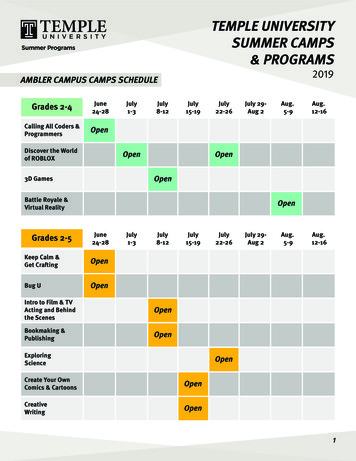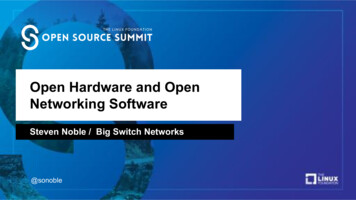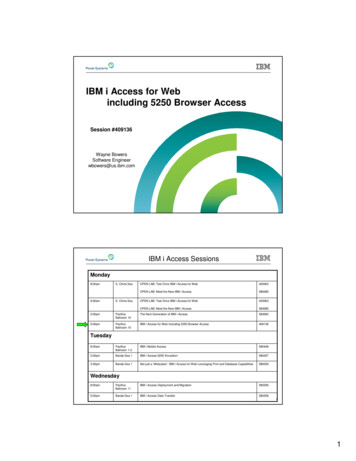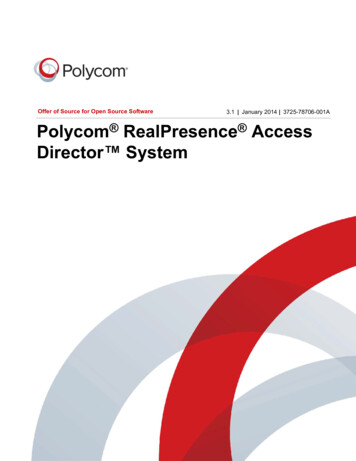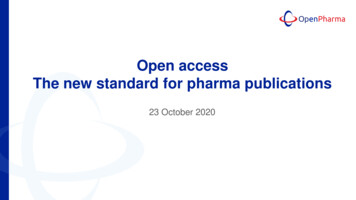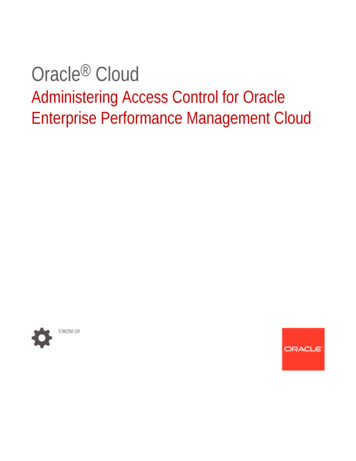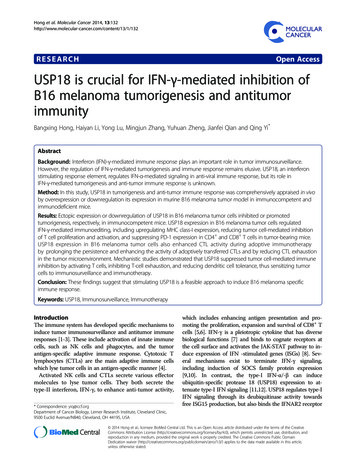
Transcription
Hong et al. Molecular Cancer 2014, /132RESEARCHOpen AccessUSP18 is crucial for IFN-γ-mediated inhibition ofB16 melanoma tumorigenesis and antitumorimmunityBangxing Hong, Haiyan Li, Yong Lu, Mingjun Zhang, Yuhuan Zheng, Jianfei Qian and Qing Yi*AbstractBackground: Interferon (IFN)-γ-mediated immune response plays an important role in tumor immunosurveillance.However, the regulation of IFN-γ-mediated tumorigenesis and immune response remains elusive. USP18, an interferonstimulating response element, regulates IFN-α-mediated signaling in anti-viral immune response, but its role inIFN-γ-mediated tumorigenesis and anti-tumor immune response is unknown.Method: In this study, USP18 in tumorigenesis and anti-tumor immune response was comprehensively appraised in vivoby overexpression or downregulation its expression in murine B16 melanoma tumor model in immunocompetent andimmunodeficient mice.Results: Ectopic expression or downregulation of USP18 in B16 melanoma tumor cells inhibited or promotedtumorigenesis, respectively, in immunocompetent mice. USP18 expression in B16 melanoma tumor cells regulatedIFN-γ-mediated immunoediting, including upregulating MHC class-I expression, reducing tumor cell-mediated inhibitionof T cell proliferation and activation, and suppressing PD-1 expression in CD4 and CD8 T cells in tumor-bearing mice.USP18 expression in B16 melanoma tumor cells also enhanced CTL activity during adoptive immunotherapyby prolonging the persistence and enhancing the activity of adoptively transferred CTLs and by reducing CTL exhaustionin the tumor microenvironment. Mechanistic studies demonstrated that USP18 suppressed tumor cell-mediated immuneinhibition by activating T cells, inhibiting T-cell exhaustion, and reducing dendritic cell tolerance, thus sensitizing tumorcells to immunosurveillance and immunotherapy.Conclusion: These findings suggest that stimulating USP18 is a feasible approach to induce B16 melanoma specificimmune response.Keywords: USP18, Immunosurveillance, ImmunotherapyIntroductionThe immune system has developed specific mechanisms toinduce tumor immunosurveillance and antitumor immuneresponses [1-3]. These include activation of innate immunecells, such as NK cells and phagocytes, and the tumorantigen-specific adaptive immune response. Cytotoxic Tlymphocytes (CTLs) are the main adaptive immune cellswhich lyse tumor cells in an antigen-specific manner [4].Activated NK cells and CTLs secrete various effectormolecules to lyse tumor cells. They both secrete thetype-II interferon, IFN-γ, to enhance anti-tumor activity,* Correspondence: yiq@ccf.orgDepartment of Cancer Biology, Lerner Research Institute, Cleveland Clinic,9500 Euclid Avenue/NB40, Cleveland, OH 44195, USAwhich includes enhancing antigen presentation and promoting the proliferation, expansion and survival of CD8 Tcells [5,6]. IFN-γ is a pleiotropic cytokine that has diversebiological functions [7] and binds to cognate receptors atthe cell surface and activates the JAK-STAT pathway to induce expression of IFN -stimulated genes (ISGs) [8]. Several mechanisms exist to terminate IFN-γ signaling,including induction of SOCS family protein expression[9,10]. In contrast, the type-I IFN-α/-β can induceubiquitin-specific protease 18 (USP18) expression to attenuate type-I IFN signaling [11,12]. USP18 regulates type-IIFN signaling through its deubiquitinase activity towardsfree ISG15 production, but also binds the IFNAR2 receptor 2014 Hong et al.; licensee BioMed Central Ltd. This is an Open Access article distributed under the terms of the CreativeCommons Attribution License (http://creativecommons.org/licenses/by/4.0), which permits unrestricted use, distribution, andreproduction in any medium, provided the original work is properly credited. The Creative Commons Public DomainDedication waiver ) applies to the data made available in this article,unless otherwise stated.
Hong et al. Molecular Cancer 2014, /132to inhibit JAK/STAT activation [12]. Whether USP18 alsoregulates IFN-γ signaling is still not completely understood.In this report, we investigated the function of USP18in IFN-γ signaling in B16 melanoma cells in vitro andin vivo and found that IFN-γ or CTLs activated USP18expression in tumor cells. Mechanistic studies usingimmuocompromised mice or immune cells depletion, orantigen-specific CTL immunotherapy showed that USP18expression in B16 melanoma cells was essential for maintaining tumor antigen-specific CTL activity, persistence,and for IFN-γ signaling-mediated tumor immunesurveillance. This study is not only important for elucidating theregulation of CTL immunotherapy, but also provides a scientific basis for developing novel immunotherapeutic strategies to target USP18 in B16 melanoma cells to induceinnate and adaptive immune responses against tumors.Materials and methodsMaterials and antibodiesAdenovirus containing mouse USP18 (Ad-mUSP18)was purchased from Applied Biological Materials Inc.(Richmond, BC, Canada). We prepared lentivirus constructs containing mouse USP18 shRNA. Rabbit and goatanti-mouse USP18 antibodies were kindly provided by Dr.Ethan Dmitrovsky (Dartmouth-Hitchcock Medical center,Dartmouth College, USA) or purchased from Santa CruzBiotechnology.Mouse modelsC57BL/6, NOD-SCID-IL2Rγ / (NSG), Ifng / , OT-1 andOT-2 C57BL/6 and pmel-1 C57BL/6 transgenic mice werepurchased from Jackson Laboratory. All mice were 6- to7 weeks of age at the time of experiment, and at least 5mice per group were used in each experiment. Mice werehoused and experimental procedures were performed in accordance with the IACUC guidelines at University of TexasMD Anderson Cancer Center and Cleveland Clinic.Generation of stable USP18 overexpression andknockdown cancer cellsPage 2 of 12model, 0.3- to 1.0 million of tumor cells were intravenouslyinjected, and lung tumor foci were counted to assess tumorburdens. In some experiments, the tumor model was firstestablished, followed by adoptive transfer of antigenspecific CTLs to the tumor-bearing mice.Flow cytometry and cell sortingCells from tumor, spleen, lymph nodes and lung weremechanically dissociated, and the red blood cells wereremoved by ACK lysis buffer (Lonza). Cells were firstblocked with Fc antibody and then labeled with differentcombinations of antibodies. Data were acquired withan LSR Fortessa flow cytometer (BD Biosciences), andanalysis was performed using Flowjo software. Cell sorting was performed using a BD FACSAria cell sorter(BD Biosciences). Fluorochrome conjugated CD4, CD8,CD11b, NK1.1, PD1, NKG2D, CD86, MHC I, MHC II,KLRG1, IFNγ and TNFα were bought from BD Biosciences.PE conjugated OT-1 tetramer were bought from BeckmanCoulter, Inc.Cell proliferation and apoptosis assaysCell proliferation was assessed by a BrdU incorporationassay. Cells cultured in vitro were treated with 10 μMBrdU for 30 min or 16 hrs when the cells were in exponential growth. Cells were harvested and stained withBrdU-APC/7AAD. For apoptosis assay, cells were cultured until they reached exponential growth and thenwere collected and stained with Annexin-V/PI.Western blotCell lysates, 20 μg, were electrophoresed on 4-12% SDSPAGE gels, and transferred onto 0.22 μm nitrocellulosemembrane (Hybond, Amersham Biosciences, Inc.). Themembrane was then incubated with specific antibodyfollowed by horseradish peroxidase-conjugated secondaryantibody (Amersham Biosciences, Inc.). The expressedprotein was detected with an ECL Plus Western blottingdetection kit (Amersham Biosciences, Inc.).Overexpression of USP18 into the tumor cell line B16 wasaccomplished by transduction of adenovirus Ad-mUSP18followed by cell sorting to select GFP-positive tumor cells(B16-USP18, B16-OVA-USP18). Stable knockdown ofUSP18 was accomplished by lentivirus shUSP18 transduction of B16 and B16-OVA tumor cells and sorting for GFPpositive tumor cells (B16-shUSP18, B16-OVA-shUSP18).qRTPCRSubcutaneous and intravenous B16 melanoma modelsImmunohistochemisty stainingSubcutaneous and intravenous murine melanoma modelswere established as described elsewhere [13]. Briefly, for thesubcutaneous tumor model, 0.5- to 1.0 million B16-OVAshCon, B16-OVA-USP18, B16-OVA-shUSP18 tumor cellswere subcutaneously inoculated. For the intravenous tumorParaffin-embedded tumor tissues were processed withpH9.0 antigen retrieval buffer. The slides were blockedwith 3% H2O2 and the serum of the species of secondaryantibody. The primary antibody was incubated at 4 Covernight. Slides were washed and secondary antibodymRNA was prepared from cells or tissues using a QiagenRNAeasy Kit. cDNA was synthesized using an ABI Biosystems cDNA synthesis kit. Quantitative PCR was conductedwith SYBR Green Master Mix (Life Technologies) and runin an ABI750 thermal cycler. The primers for USP18 are:5′-atgcaggacagtcgacagaa-3′ and 5′- tgtcaagtctgtgtccgtga-3′.
Hong et al. Molecular Cancer 2014, /132was incubated for 20 min at room temperature. Slideswere washed three times with 1 PBST and then developed with DAB and counterstained with H&E andmounted for microcopy analysis.Coculture of OT-1 and OT-2 cells with B16-OVA-USP18tumor cellsB16-OVA-GFP or B16-OVA-USP18 tumor cells werecocultured with or without IFN-γ sensitization (5 ng/ml)and subjected to low dose (10 Gy) irradiation. OT-1and OT-2-naive T cells were cocultured with irradiatedtumor cells for 48- to 72 hours. T-cell proliferation wasanalyzed by a CFSE dilution assay or 3H-incorporationassay. IL-2 and IFN-γ secretion from cocultured T cellswas analyzed by ELISA.Statistical analysisGroups were compared using a student’s t-test. Differences were considered significant when p 0.05. All dataare presented as mean SEM.ResultsIFN-γ signaling induces USP18 expression in tumor cellsduring immunosurveillanceIFN signaling plays important roles in cell activity, including cell growth, differentiation, proliferation, andimmune regulation. IFN signaling also is critical forimmunosurveillance for tumorigenesis and metastasis[5], including surveillance for induction of MHC class-Imolecule expression on tumor cells [14]. We first verified that IFN-α/-β or IFN-γ stimulation increased MHCclass-I expression on tumor cells (Additional file 1:Figure S1A). Inoculated tumor cells in IFN-γ signalingdeficient (Ifng / ) mice had reduced MHC class-I expression (Additional file 1: Figure S1B).IFN signaling is regulated by various molecules and thecanonical factors are the IFN-sensitive response elements(ISREs) [8]. USP18 is an IFN stimulated gene that has beenreported to regulate type-I IFN signaling in the anti-viralimmune response [12]. To our knowledge, very few studieshave investigated USP18 regulation of type-II IFN signalingin tumor immunosurveillance. We assessed USP18 mRNAand protein levels in B16 tumor cells after IFN-α or IFN-γstimulation and found that IFN-γ was a more potent inducer than IFN-α for USP18 expression (Figure 1A andB), as well as Stat1 phosphorylation, which is IFN-γ signaling downstream gene (Figure 1B). Western blot analysisshowed that IFN-γ induced USP18 protein expression inother tumor cell lines such as 4 T1 and EMT6 tumor cells(Figure 1C). To investigate whether endogenous IFN signaling induces USP18 expression during tumor developmentin vivo, we inoculated C57BL/6 mice with B16-GFP tumorcells. Tumor cell USP18 expression was increased in vivoas compared with in vitro conditions (Figure 1D). ToPage 3 of 12examine exogenous IFN signaling, such as CTL secretionof IFN-γ, we performed adoptive transfer of activated OT-1cells, which resulted in stronger USP18 expression in tumorcells in vivo (Figure 1D). Similar results were found in in vitro coculture (Figure 1E). These results demonstrated thatUSP18 was expressed in tumor cells during tumor development regardless of whether IFN signaling was endogenousor exogenous.USP18 expression in tumor cells suppresses tumorgrowth in vivoTo determine whether tumor cell USP18 expression contributes to tumorigenesis in vivo, we stably silenced orectopically expressed USP18 in B16-OVA tumor cells(Additional file 1: Figure S2A and B). As IFN signalingwas required for USP18 expression in tumor cells, knockdown of USP18 was confirmed after IFN-γ stimulation(Additional file 1: Figure S2A). We found that USP18knockdown or overexpression did not affect the proliferation or apoptosis status of the cells, either with or withoutIFN-γ stimulation (Additional file 1: Figure S2C and D).B16-OVA-shCon (control), B16-OVA-shUSP18 (USP18knockdown), or B16-OVA-USP18 (USP18 overexpression)cells were then intravenously inoculated into immunocompetent C57BL/6 mice. Knockdown of USP18 expressionsignificantly increased tumor burden in C57BL/6 mice(Figure 2A and B, and Additional file 1: Figure S3) andshortened mouse survival time (Figure 2C). Conversely,overexpression of USP18 in B16-OVA tumor cells significantly reduced tumor burden in C57BL/6 mice (Figure 2Dand E, and Additional file 1: Figure S3) and prolongedmouse survival time (Figure 2F). As tumor cells were intravenously injected into mice, the change in tumor burdenwas not due to the difference of invasion or migration oftumor cells (Additional file 1: Figure S4A-C).In order to confirm this finding, we subcutaneously inoculated B16-OVA-shCon, B16-OVA-shUSP18, or B16OVA-USP18 tumor cells into C57BL/6 mice. Tumorgrowth in mice receiving B16-OVA-USP18 cells was significantly inhibited, whereas tumor growth was enhanced in those receiving B16-OVA-shUSP18 tumorcells (Figure 2G-I).USP18 function in tumor growth depends on theimmune systemTo explore whether regulation of tumorigenesis by USP18expression in tumor cells was due to host immune status,we intravenously inoculated B16-OVA-GFP or B16-OVAUSP18 tumor cells into NSG (NOD-SCID/IL2Rγ / ) mice,which are deficient in T, B and NK cells. In contrast to immunocompetent mice, ectopic expression of USP18 did notinhibit tumorigenesis in NSG mice (Figure 3A and B), andno significant difference of survival in tumor-bearing micewas noted (Figure 3C). However, the tumor burden was
Hong et al. Molecular Cancer 2014, /132Page 4 of 12Figure 1 USP18 expression in tumor cells with IFN-γ signaling. B16 tumor cells were stimulated in vitro with IFN-γ (10 ng/ml) (R&D systems),IFN-α (10 ng/ml) (R&D systems), or LPS (1 μg/ml) (Invivogen) for 24 hr, then harvested for qRT-PCR assay of USP18 mRNA (A) and Western blotassay (B) of USP18 and pStat1 protein expression. EMT6 and 4 T1 tumor cells were untreated or treated with IFN-γ (5 ng/ml) for 24 hr, USP18expression was analyzed by Western blot analysis (C). B16-GFP cells were subcutaneously inoculated into C57BL/6 mice until tumor sizes reachedabout 5 mm. Some mice received adoptive transfer of 5 106 activated OT-1 cells for 48 hr. B16-GFP tumor cells were collected and qRT-PCRanalysis of USP18 expression (D). B16 tumor cells were cocultured with activated OT-1 cells for 24 hr and analyzed for USP18 and pStat1expression (E).higher in NSG mice compared with immunocompetentmice for both the B16-OVA-USP18 and B16-OVA-GFP inoculation groups, suggesting that lack of the immune system or immunosurveillance enabled the tumor cells to bemore aggressive [15].CD4 and CD8 T cells and NK cells are the principalIFN-γ-producing cells, and their anti-tumor activity depends on the robustness of IFN-γ production. To determine how tumor cell USP18 affects these cells and thus theimmune response, we injected B16-OVA-GFP or B16OVA-USP18 tumor cells into C57BL/6 mice that were depleted of CD4 or CD8 T cells or NK cells and monitoredtumorigenesis. CD8 T cell depletion significantly compromised the effect of USP18 expression on tumorigenesis(Figure 3D-E). However, CD4 T cell or NK cell depletionwas less important in USP18-mediated tumorigenesis(Figure 3D-E). To further investigate the function ofUSP18 in IFN-γ-mediated immune surveillance againsttumorigenesis, B16-OVA-GFP and B16-OVA-USP18 cellswere intravenously injected into IFN-γ-knockout or widetype C57BL/6 mice. Tumor nodule formation was similarwhen B16-OVA-GFP and B16-OVA-USP18 cells were inoculated (intravenously) into IFN-γ-knockout (KO) mice(Figure 3F-G). These results showed that regulation of tumorigenesis by USP18 depended on IFN-γ signaling, mostlikely through the IFN-γ-mediated immune response.USP18 expression in tumor modulates immune cellpopulation and phenotypeDuring tumor development, a variety of mechanisms inhibits the host immune response, including secretion of inhibitory cytokines and chemokines [16] and cell-cellcontact suppression [17]. To explore USP18 function in immune suppression, we analyzed the immune status in thetumor microenvironment after USP18 overexpression intumor cells (B16-OVA-USP18), which were then intravenously injected in C57BL/6 mice. CD45 cell infiltration ofthe lung increased (Figure 4A). The percentage and the absolute number of NK cells also increased, but CD11b myeloid cell infiltration decreased (Figure 4A). Monitoring ofSIINFEKL MHC class-I-restricted tetramer-positive CD8 cells in the lung, spleen and draining lymph nodes revealedan increased antigen-specific CTL response in B16-OVAUSP18 tumor-bearing mice (Figure 4B).Host immunosurveillance against tumorigenesis is notonly determined by the potency of the antigen-specificimmune response, but also by the persistence of immuneeffector cells [18]. Tumor cells have developed specificmechanisms to induce tolerance, inhibition, and exhaustion of immune effector cells, by altering the expressionof PD-1 and KLRG1 on T cells [19,20]. Analysis of PD-1expression in CD8 T cells from B16-OVA-USP18tumor-bearing mice showed a reduced PD-1 expression
Hong et al. Molecular Cancer 2014, /132Page 5 of 12Figure 2 USP18 expression in tumor cells suppresses tumor growth in vivo. 3 105 B16-OVA-shUSP18 or B16-OVA-shCon tumor cellswere intravenously inoculated into C57BL/6 mice. Tumor growth was monitored by counting the lung tumor foci (A-B) and the survival rate(C). 2 105 B16-OVA-USP18 or B16-OVA-GFP tumor cells were intravenously inoculated into C57BL/6 mice. Tumor growth was monitored bycounting the lung tumor foci (D-E), and mouse survival rate over time (F). 1 106 B16-OVA-USP18 or B16-OVA-GFP, or B16-OVA-shUSP18 tumorcells were subcutaneously inoculated into C57BL/6 mice. The tumor growth was monitored as tumor volume and by H&E staining (G-I).in the blood and draining lymph nodes compared toB16-OVA-GFP tumor-bearing mice (Figure 4C).We speculated that USP18 expression in tumor cellsmight lead to secretion of soluble factors that also contribute to the immune activation. Cytokine array analysisof culture supernatant from USP18 overexpression andknockdown B16-OVA tumor cells did not show significant differences (Additional file 1: Figure S5A), butanalysis of a chemokine panel showed that in B16-OVAUSP18 cells, increased secretion of chemokines relatedto NK cell migration was observed (Additional file 1:Figure S5B). In regard to NK cells, not only did the ratioand absolute number of infiltrating NK cells increased inB16-OVA-USP18 tumor-bearing mice (Figure 4A), butthe activation status of the infiltrating NK cells also increased, as evidenced by detection of the activation receptor NKG2D (Figure 4D).ISG15 is an IFN-induced gene that is regulated byUSP18 [21]. In free form, ISG15 can activate NK cellsand antigen presentation cells [22,23], and a recent studyshowed that human ISG15 deficiency leads to mycobacterial disease [24]. To detect ISG15 in the tumormicroenvironment, tumor lysate was prepared from B16-OVA-GFP, B16-OVA-USP18 or B16-OVA-shUSP18 tumors, and ELISA or western blot analysis showed thatthe ISG15 level was higher in B16-OVA-USP18 tumorthan in B16-OVA-GFP tumor, but lower in B16-OVAshUSP18 tumor (Figure 4E, Additional file 1: Figure S6).We further investigated dendritic cell activity in thetumor microenvironment. CD11c dendritic cells weretolerized in the tumor stroma during tumor development [25]. Isolation of CD11c dendritic cells from B16OVA-USP18 tumor bearing mice showed that these cellswere activated instead of tolerized, because the expression of CD86 and MHC class-II was higher (Figure 4F),and more TNF-α but less IL-10 were secreted after restimulation in vitro as compared with B16-OVA-GFPtumor bearing mice (Figure 4G).USP18 expression inhibits immune suppression mediatedby tumor cellsAs USP18 expression in tumor cells affects CD8 T-cellfunction in vivo, B16-OVA-GFP or B16-OVA-USP18cells were irradiated and then cocultured with OT-1 Tcells in vitro to analyze T-cell activation. B16-OVAUSP18 tumor-cell coculture significantly increased OT-
Hong et al. Molecular Cancer 2014, /132Page 6 of 12Figure 3 USP18 function in tumor growth depends on the immune system. 3 105 B16-OVA-USP18 or B16-OVA-GFP tumor cells wereintravenously inoculated into NSG mouse. The tumor burden (A-B) and mice survival rate (C) were analyzed. 3 105 B16-OVA-USP18 orB16-OVA-GFP tumor cells were intravenously inoculated into C57BL/6 mice with or without depletion of CD8 or CD4 T cells, or NK1.1 NK cells,and the tumor burden in the lung was monitored (D-E). 3 105 B16-OVA-GFP, or B16-OVA-USP18 tumor cells were intravenously inoculated intoC57BL/6, or Ifng / B6 mice. Tumor growth was monitored (F-G).1 T-cell proliferation (Figure 5A), but also increasedOT-1 T-cell secretion of IL-2 and IFN-γ (Figure 5B).Moreover, secretion of IL-2 and IFN-γ was even greater when OT-1 T cells were cocultured with IFN-γsensitized B16-OVA-USP18 tumor cells as comparedwith B16-OVA-GFP cells (Figure 5C). Activated T cellsexpress inhibitory molecules, such as PD-1, to preventover-activation [26]. We found that ectopic expressionof USP18 in B16-OVA cells significantly inhibited PD-1expression on cocultured OT-1 T cells (Figure 5D). Thisphenomenon was also seen in T cells from B16-OVAUSP18 cell inoculated mice (Figure 4C). Moreover, ectopicUSP18 expression in B16-OVA tumor cells significantlyincreased the CTL activity of activated OT-1 cells in vitro(Figure 5E). CD4 T cells also played a role in tumorimmunosurveillance. Irradiated B16-OVA-USP18 cellsstimulated OT-2 T cells to proliferate (Figure 5F) and secrete more IL-2 and IFN-γ (Figure 5G) after the coculture.Furthermore, overexpression or knockdown USP18 inB16-OVA cells did not affect OVA antigen expressionlevel in tumor cells (Additional file 1: Figure S7),excluding the possibility that USP18 could regulateantigen expression.Inhibition USP18 activity in tumor cells compromisesantigen-specific CTL activityAs we found that endogenous IFN-γ signaling affectedtumorigenesis through IFN-γ-induced USP18 expressionin tumor cells and regulated immune-cell function inthe tumor microenvironment, we wanted to explorewhether USP18 expression in tumor cells affected exogenous IFN-γ-secreting CTL activity. Antigen-specificIFN-γ-secreting CTLs play an important role in antitumorimmunity [27]. To analyze CTL activity in B16-OVAshCon and B16-OVA-shUSP18 tumors, we intravenouslyinjected 1 106 B16-OVA-shCon cells or B16-OVAshUSP18 cells into CD45.1 C57BL/6 mice for 8 days,followed by adoptive transfer of 5 106 activated OT-1(CD45.2 ) cells into tumor-bearing mice. Monitoring forpersistence of CD45.2 OT-1 cells in the lung, draininglymph nodes and spleen of tumor-bearing mice showedthat OT-1 CTLs were rapidly exhausted in B16-OVA-
Hong et al. Molecular Cancer 2014, /132Page 7 of 12Figure 4 USP18 expression in tumor modulates immune cell population and phenotype. C57/BL6 mice received intravenous inoculation of3 105 B16-OVA-USP18 or B16-OVA-GFP tumor cells. 2 weeks later, T cell, CD11b myeloid cell and NK cell infiltration in the lung was analyzed byflow cytometry (A). Antigen-specific OT-1 tetramer-positive CD8 T cells in the lung draining lymph nodes (DLN), lung, and spleen were analyzed(B). PD-1 expression on CD8 T cells (C) was analyzed. NKG2D expression on NK cells in tumor microenvironment was monitored by flowcytometry (D). ISG15 levels in B16-OVA-GFP, B16-OVA-USP18 or B16-OVA-shUSP18 tumor lysate was analyzed by ELISA (E). CD11c dendritic cellswere isolated from B16-OVA-GFP, or B16-OVA-USP18, and B16-OVA-shUSP18 lung melanoma and cultured in vitro with or without LPS. Dendriticcell maturation and cytokine were assayed by flow cytometry and ELISA, respectively (F-G).shUSP18 tumor-bearing mice (Figure 6A). Tetramer(Figure 6B) and intracellular staining for IFN-γ and TNFα (Figure 6C) demonstrated a loss of CTL activity in B16OVA-shUSP18 tumor-bearing mice. Analysis of the T-cellexhaustion markers PD-1 and KLRG1 showed that the expression of these molecules was greater on OT-1 cells inB16-OVA-shUSP18 tumor-bearing mice than B16-OVAshCon tumor-bearing mice (Figure 6D). These data indicated that USP18 expression in tumor cells regulated theIFN-γ-secreting activity and persistence of the CTLs inthe tumor microenvironment.Ad-USP18 and CTL combination immunotherapy insubcutaneous B16 melanoma modelOur study showed that USP18 expression in tumor cellsregulated tumorigenesis and IFN-γ secretion by exogenous CTLs as part of the anti-tumor immune response.Next, we investigated the possibility that use of USP18could enhance CTL activity against subcutaneous B16melanoma. After B16-OVA-GFP, B16-OVA-USP18, orB16-OVA-shUSP18 tumor cells were subcutaneously inoculated into C57BL/6 mice, tumor growth in mice receiving B16-OVA-USP18 cells was significantly inhibited,whereas tumor growth was promoted in those receivingB16-OVA-shUSP18 tumor cells (Figure 2G). Next, we determined whether MHC class-I and PD-L1 expression differed in subcutaneous B16-OVA-USP18 tumor from thatof B6-OVA-GFP tumor. Results showed that ectopic expression of USP18 increased MHC class-I and reducedPD-L1 expression (Figure 7A). As MHC class-I and PD-L1expression on tumor cells significantly affected host immunosurveillance, we also detected greater OT-1 tetramerpositive CD8 CTL infiltration in B16-OVA-USP18 tumorthan those in B16-OVA-GFP tumor (Figure 7B). Moreover,
Hong et al. Molecular Cancer 2014, /132Page 8 of 12Figure 5 Immune suppression by tumor cells is regulated by USP18 expression. B16-OVA-GFP or B16-OVA-USP18 tumor cells without (A-B)or with IFN-γ sensitization (5 ng/ml) (C) were irradiated and cocultured with naïve OT-1 T cells. Cell proliferation (A) and IL-2 and IFN-γ secreteion (B-C)of the T cells were analyzed. PD-1 expression in cocultured OT-1 cells was monitored by flow cytometry (D). The CTL activity of activated OT-1 cellsagainst B16-OVA-GFP and B16-OVA-USP18 was analyzed (E). B16-OVA-USP18 cells with or without IFN-γ (10 ng/ml) sensitization were irradiated andcocultured with naive OT-2 T cells for 72 hrs, and OT-2 T-cell proliferation (F) and cytokines IL-2 and IFN-γ secreteion (G) were analyzed.more effector T cells were activated in B16-OVA-USP18tumor and spleen compared with B16-OVA-GFP tumorand spleen (Additional file 1: Figure S6A and B). However,there was no difference in infiltrating regulatory T cells between B16-OVA-USP18 and B16-OVA-GFP subcutaneoustumor (Additional file 1: Figure S6C).Next we explored whether delivery of USP18 into thetumor microenvironment enhances CTL activity againstsubcutaneous B16-OVA tumor. A subcutaneous B16-OVAtumor model was established in C57BL/6 mice. At day 5, activated OT-1 CTLs were adoptively transferred to the mice,together with intra-tumor injection of adenovirus vector expressing USP18 (Ad-USP18). Adoptive transfer of OT-1CTLs induced partial tumor shrinkage (Figure 7C). AdUSP18 injection increased OT-1 CTL activity and tumorshrinkage (Figure 7C). Detailed analysis of the immune status in tumor-bearing mice showed that Ad-USP18 significantly increased the duration of CTL persistence in thespleen and tumor sites of tumor-bearing mice (Figure 7D).As tumor antigens are weakly immunogenic, dendriticcell vaccination and IL-2 treatment are usually used toincrease CTL activity clinically [28]. Using our B16tumor model, we co-administered pmel-1 CTLs, Ad-USP18, IL-2 and dendritic cells into tumor. Injection ofAd-USP18 significantly increased pmel-1 CTL activityand caused tumor shrinkage (Figure 7E).DiscussionThe novel finding in this study is the discovery that theubiquitin-specific peptidase USP18 can be induced by IFNγ in tumor cells and plays important roles in inhibitingtumorigenesis and antitumor immunity. We found thatUSP18 is expressed in tumor cells after IFN-γ signalingstimulation. Ectopic expression of USP18 in tumor cellssuppressed tumorigenesis and antitumor immune responsewhereas inhibition of USP18 expression promoted tumorigenesis and immunosurveillance. Mechanistically, USP18expression in tumor cells modulated immune-cell population and phenotype in tumor microenvironment. Moreover,USP18 controlled exogenous IFN-γ producing antigenspecific CTL persistence in antitumor immunity.Many signaling pathways are involved in the regulation oftumorigenesis and immunosurveillance. Type-I and-II IFNsare central in a broad signaling network that regulatestumor-cell proliferation and apoptosis, and modifies boththe anti-viral and antitumor immune responses. Type-I IFN
Hong et al. Molecular Cancer 2014, /132Page 9 of 12Figure 6 Inhibition of USP18 activity in tumor cells compromises antigen-specific CTL activity. CD45.1 C57BL/6 mice received intravenousinoculation of 1 106 B16-OVA-shCon and B16-OVA-shUSP18 tumor cells. At day 8, 5 106 activated CD45.2 OT-1 CTLs were intravenouslyinjected into tumor-bea
ences were considered significant when p 0.05. All data are presented as mean SEM. Results IFN-γ signaling induces USP18 expression in tumor cells during immunosurveillance IFN signaling plays important roles in cell activity, in-cluding cell growth, differentiation, proliferation, and immune regulation. IFN signaling also is critical for



